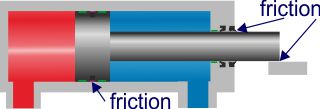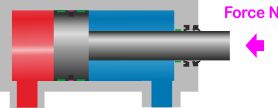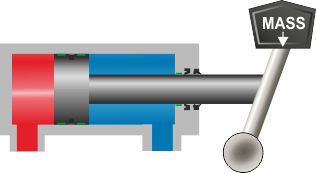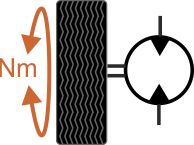Self-study lesson plans and training record download page.
Importance of understanding loads
Understanding the loads that are acting on a hydraulic system is vital for knowing why the hydraulic circuit is designed in a particular way. In fact, you can't really start to design a circuit unless you understand the loads. Moreover, knowing the load is often the key piece of intellectual property (IP) that defines who gets the order to design the equipment in the first place. For this reason it is not unusual for companies to keep certain bits of information to themselves to protect their machine performance advantages or equipment supply contracts.
Frictional loads

Friction is a resistance to movement and will occur at the cylinder seals and load interfaces. It consists of 'stiction' or 'breakout' friction and 'dynamic' friction. Although friction results in a loss of energy and heat being generated it can be beneficial for damping out load oscillations. It's likely that without seal friction the cylinders would oscillate or creep and be sensitive to back pressure variations. So friction makes our circuit design very easy and should require no extra valves to control.
Gravitational mass loads

Mass acting on a cylinder will translate directly into a pressure within the fluid. The mass may act in compression (as shown), as a load onto the bore area or in tension, as a load onto the annulus area.
If we only have a mass load acting in one direction then our circuit design remains fairly simple, except that you can't turn gravity off. The load still acts on the cylinder when the power is turned off, which means we still need protection and controls to hold the load and stop it from falling.
But remember, even with this protection we will still get Cylinder Creep over time. What this means is that if you leave hydraulic valves supporting a load the likelihood is that these valves will leak a few drops of fluid every minute and over time this loss of fluid will result in the cylinder dropping the load. NEVER rely on hydraulics to hold an unsupported load. It might fall on someone.
Load forces

Often the load will have nothing to do with a vertical mass but is generated by clamping pressures or the forces to move some other equipment etc.
It is usually quite simple to design a circuit that has a consistent load force. The problem comes if the forces keep changing as this can affect the pressure drops across the valves and therefore the flow rates and speeds or feeds.
Complex loads

In many applications the loads can be very complex. In this image we see a mass that is pivoted about a swinging arm. The direction in which this mass will act on the cylinder rod will change as the arm swings over-centre.
Our circuit will now have to compensate for potential speed changes as the load pressure drops change. It will also have to provide load holding protection in both directions as the load could fall or creep either way.
Motor loads

Masses, frictions and forces will affect motor loads in the same way they do for cylinders. However, because motors do not have end stops or cushions they also tend to suffer more from the over-running loads when they stop e.g. as a driver brakes his vehicle by slowing the motor speed, the mass of the vehicle will try to continue which can put huge loads on the motor itself.
It's common for motor circuits to include over-run valves to protect against excess pressure caused by this.
Unexpected operating condition
There should never be any operating conditions that have not been expected and planned for. These should include first assembly, breakdown, testing, storage, maintenance, start-up and shut-down. All possible situations should be considered including accidental impact, operator errors and temperature changes etc. from extreme environmental conditions. 'Murphy's law' clearly states that anything that can go wrong, will go wrong so make sure it will not damage your systems when it does.